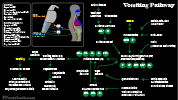Cyclic Vomiting Syndrome, Cyclical Vomiting Syndrome, Periodic Vomiting Disorder
- See Also
- Epidemiology
-
Incidence in chronic unexplained Vomiting
- Adults: 3 to 14% (mean diagnosis age 25 years)
- Children: <2% (mean diagnosis age 5 years)
- Ethnicity
- More common in caucasian patients
- Gender
- Slightly more common in males
- Associated with frequent Emergency Department visits (mean 15 before diagnosis)
- Delayed Diagnosis is common
- Venkatesan (2010) BMC Emerg Med10:4 +PMID: 20181253 [PubMed]
- Definitions
- Pathophysiology
- Unknown cause and multiple hypotheses
-
Cyclic Vomiting Syndrome is highly associated with Migraine Headaches
- Children: Up to 75% will develop Migraine Headaches
- Adults: Up to 36% have Migraines
- Images
- Symptoms
- Triggers
- Emotional stress
- Sleep deprivation
- Menstruation
- Tyramine-Vasoactive Amines (e.g. Chocolate, cheese, monosodium Glutamate)
- Daily Cannabinoid use (see Cannabinoid Hyperemesis Syndrome)
- Phases
- Prodromal: Aura (variably present, lasts minutes to days)
- Anorexia
- Abdominal Pain
- Lethargy
- Pallor
- Autonomic Symptoms (Sweating, Salivation)
- Acute Vomiting and Hyperemesis
- Episodic intense Nausea and Vomiting
- Children with 9 to 10 episodes per year on average
- Adults with 14 to 15 episodes per year on average
- Vomiting may occur as often as 8 times every hour
- Onset typically in early morning or middle of the day
- Duration 1 to 5 days
- Children average 3 to 4 days
- Adults average 6 days
- Episodic intense Nausea and Vomiting
- Recovery
- Vomiting ceases
- Energy recovers
- Appetite returns
- Inter-episode Remission
- Asymptomatic between episodes
- Prodromal: Aura (variably present, lasts minutes to days)
- Associated Conditions
- Migraine Headaches (frequently cited)
- Menstrual periods (catamenial Cyclic Vomiting Syndrome)
- Diabetes Mellitus
- Pregnancy
- Differential Diagnosis
- See Vomiting Causes in Children
- See Vomiting in Pregnancy (Morning Sickness)
- See Vomiting in Cancer
- See Psychogenic Vomiting
- See Medication Induced Vomiting
-
Cannabinoid Hyperemesis Syndrome
- See Cannabinoid Hyperemesis
- May be a subset of Cyclic Vomiting Syndrome
- Chronic Nausea Vomiting Syndrome
- Other rare conditions with similar presentations
- Acute Intermittent Porphyria (associated neurologic findings)
- Disorders of Fatty Acid Metabolism
- Medium-chain-acyl-CoA Dehydrogenase Deficiency
- Carnitine palmityltransferase deficiency (deficiency of the mitochondrial translocation)
- Diagnosis
- Cyclic Vomiting Syndrome (CVS)
- Episodic, stereotypical Vomiting
- At least 2 acute episodes in past 6 months
- Rome IV only requires 2 episodes for CVS Diagnosis
- International Headache Society requires 5 episodes for CVS diagnosis
- Each episode occurs at least 1 week apart
- Each episode lasts <1 week
- At least 2 acute episodes in past 6 months
-
Vomiting is absent between episodes
- However, more mild symptoms may be present between episodes
- Evaluation
- Exclude serious causes of Chronic Vomiting
- See Chronic Vomiting for red flag findings and recommended laboratory testing
- Management
- See Antiemetic
- See Vomiting Management in Children
- See Vomiting in Pregnancy
- See Postoperative Nausea and Vomiting
- See Vomiting in Cancer
- Trigger Avoidance
- See triggers above (includes Cannabinoids)
- Abortive management
- See Cannabinoid Hyperemesis Syndrome
- Background
- Little evidence for emergency department management for Cyclic Vomiting Syndrome
- Author has had success in the Emergency Department with Dopaminergic Antiemetics
- Recommends slow infusion over 15 minutes in a piggy back bag to prevent Dystonic Reaction
- Authors greatest success (anecdotal) has been with Droperidol or Olanzapine
- Author has had poor success with Ondansetron in the emergency department for CVS
- Emergency Department
- Intravenous Fluids (e.g. D5LR)
- Dopaminergic agents
- Other agents
- Home abortive management
- Prophylactic Medications
- Efficacy
- Effective for chronic remission (or reduction of episodes) in 70% of cases
- Worse prognosis for remission in several sub-groups
- Poorly controlled Migraine Headaches
- Psychiatric Disorders
- Chronic Opioid use
- Cannabinoid Hyperemesis Syndrome
- Prophylactic agents also commonly used in Migraine Headache Prophylaxis
- Supplements with evidence of benefit
- Efficacy
